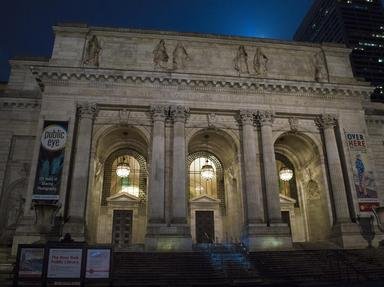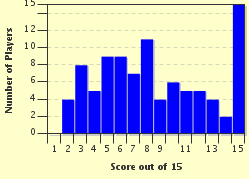Quiz Answer Key and Fun Facts
1. One of the most famous poets of early American literature is an individual who, along with his poetry, was unknown by most Americans until the twentieth century. In fact, during his lifetime he was hardly known outside of the Massachusetts frontier town of Westfield, where he was a minister and physician. Who is this author of such poems as "Upon a Wasp Chilled with Cold", "A Fig for Thee, Oh! Death", and "Huswifery" (a poem in which the speaker asks God to "Make me Thy Loom")?
2. This individual is known for his exploration more than for his writing; nevertheless, his letters and journals were instrumental to the growing popular view of the New World as a paradise. In his "Letter to Luis de Santangel Regarding the First Voyage", he concluded, "Espanola is a marvel" and spoke of heavenly things such as nightingales and honey (though neither was truly present) as well as "trees of a thousand kinds" that did "seem to touch the sky." Who wrote this letter?
3. This Spanish explorer was part of the Panfilo de Narvaez expedition to Florida; however, he ended up a prisoner and slave of the Karankawa Indians for about two years. Later, he was imprisoned by his own countrymen because he fought their hunting and enslaving Indians. Who is this individual whose narrative of his experiences in present-day Florida, Texas, New Mexico, and Mexico became a significant record for anthropologists and other scientists? (Think of a cow's head)
4. According to one version of the American Indian creation story originating among the Iroquois people, the world "was in great darkness" in the beginning. Then a pregnant woman fell from the sky onto the back of which animal, which began to grow larger until it "became a considerable island of earth"?
5. Several American Indian cultures have a cycle of tales about a deceitful, mischievous, and bawdy character who creates chaos among those it visits yet is instrumental in the establishment of morals and mores. One of the tales in the Winnebago cycle, for example, tells of this character's decision to use animal parts to give itself female genitalia and breasts so that it can persuade a chief's son to marry it and keep it safe. What is the term used by scholars to refer to this character?
6. This English naturalist and Oxford scholar was hired by Sir Walter Raleigh to train him and his men in navigation and to accompany them to Virginia to record their findings. He published "A Brief and True Report of the New Found Land of Virginia", which essentially was propaganda to encourage settlement of Roanoke despite the "savages" many of the English feared. Who is this man who argued that the Indians' "best defense" was "turning up their heels against us in running away"?
7. This English soldier and explorer helped to establish Jamestown. In his famous "General History of Virginia, New England, and the Summer Isles", he tells of how, while using an Indian guide as his shield, he single-handedly held off "200 savages" until he finally surrendered because of exhaustion but then was rescued by a chief's daughter. Who is this individual who eventually left Jamestown after a bag of gunpowder exploded in his lap while he was sleeping?
8. This individual wrote "Of Plymouth Plantation" partly to justify the presence of the Pilgrims in the New World. Who is this author who claims "it pleased God" to allow one of the "Mayflower" crew to die and be thrown overboard and who uses Thomas Morton's activities as proof that people with freedom will freely perform evil deeds, such as write lewd poetry and dance around a Maypole?
9. This Puritan governor of the Massachusetts Bay Colony delivered a famous sermon on board the "Arbella" as he and several colonists traveled from England to the New World. Who composed the sermon "A Model of Christian Charity", which contains the following famous words: "For we must consider that we shall be as a city upon a hill"?
10. This theologian wrote many tracts defending freedom of conscience and arguing for the separation of church and state. He also wrote "A Key into the Language of America" in which he not only provided a useful tool for interpreting American Indian speech but also presented native societies as truly civilized. Who is this man, who later founded Providence Plantation in what would become Rhode Island?
11. This Puritan wrote a diverse body of poetry that included devout and pious works such as "Contemplations" as well as pieces that portrayed her struggles with life and faith such as "Before the Birth of One of Her Children". Who is this woman who became the first published New England poet despite her intentions not to be published?
12. This writer's claim to literary fame is a narrative of his or her captivity after being abducted by the Wampanoags. It became the first in a genre called Indian captivities and was a sensation not only because of its graphic violence (the Indians "knocked [a man] in the head, and stripped him naked, and split open his bowels") but also because of its extreme Puritanism (the author claims God keeps the Indians alive to punish His people, the English, for their sinfulness). What is the name of the author of this narrative?
13. This Puritan minister believed he was unworthy of God and doomed to hell because of nocturnal emissions that occurred early in his life. Who is this individual who wrote the lengthy poem "The Day of Doom", which became a bestseller in New England during the 1600s and remained a most popular work among Puritan and other religious readers into the 1800s?
14. This individual published "Magnalia Christi Americana", probably his most significant work among the 450 books and pamphlets he wrote, in 1702. All of his writings urged New Englanders to return to the religious fervor of the original Puritan settlers. Who is this individual who had a tremendous impact on the popularity of smallpox inoculation and who was highly influential during the Salem witch trials because of his support of allowing "spectral evidence"?
15. Edward Taylor wrote a great number of poems, each one composed before the monthly communion ritual in his church. They allowed him to synthesize the emotional and intellectual content of his sermon while he spoke directly and fervently with God. In these poems, he would rely heavily on conceits, such as those in which he compares himself to a crumb of dust, Christ to a sugar cake, God's love to the vapors of apple cider, and his own sinful heart to a chest sealed with a rusted lock. What is the name of his lengthy collection of metaphysical poetry?
Source: Author
alaspooryoric
This quiz was reviewed by FunTrivia editor
looney_tunes before going online.
Any errors found in FunTrivia content are routinely corrected through our feedback system.

